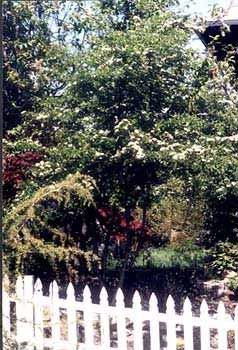 Our Hawthorn Trees
Our Hawthorn Trees
"The thorn trees hold their berries high
In crowded scarlet to the sky
No beads so red were ever seen
When gypsies came upon the green."
-Rachel Field (1894 - 1942)
"We will bless yon leafy bow'r
Where we spent the midnicht hour
'Neath the hawthorn's scented flower,
My bonnie lassie-o."
-Scottish ballad "Fordell Ball"
by Jim Dunn
by Jim Dunn
We have five hawthorn trees that came with the house. I'm mostly confident they are Crataegus ambigua, the Russian Hawthorn, rather than English Hawthorn, as the Russian has the more overt & showy berries in vaster numbers, very sharp half-inch thorns, & clusters of white flowers in May, often with a decided pink blush. The bright red berries cling to the branches most of the winter, but will eventually turn black & fall, at latest just before new leafage comes in Spring.
These trees don't require pruning as die-back is rare for any reason & it takes care of itself. On the other hand it is very forgiving of being pruned or underlimbed for trained effects, & to trim out excessive twigs for tidier appearance or to just lop off thorny limbs that are dangerously in the way of paths.
Left to its own devices it becomes a multitrunked enormous vase-shaped shrub, but can be underlimbed so that one or two trunks develop to be very big around, giving it a rugged classic tree form, so that it will grow to 25 or 30 feet high, or bigger.
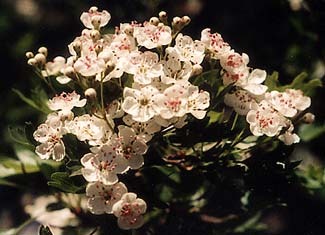 The bark is attractive & the limbs gnarly, so the trees are beautiful even after autumn, not merely for the berries that persist into winter, but for that bark & twisted structure. (There's a separate page showing the Hawthorn's Winter Bark after a snowstorm).
The bark is attractive & the limbs gnarly, so the trees are beautiful even after autumn, not merely for the berries that persist into winter, but for that bark & twisted structure. (There's a separate page showing the Hawthorn's Winter Bark after a snowstorm).The one we have growing at the foot of the front porch-steps is 12 or 15 feet tall with multiple-trunks, a huge fountaining shrub that frequently needs some trimming to keep thorns away from the path. It has the vase-shape appearance typical of C. ambigua in its untrained state.
A second one that overhangs a partially sunken garage is all twisty & weird-limbed & has grown partially sideways rather than upright, probably because of the initial difficulty it must have had getting above the garage to sunlight, or due to competition for resources with a nearby Douglas Fir (this particular hawthorn can be seen in the first photo on the Douglas Fir page). It is actually quite a remarkable specimen, as no one ever trained it that I'm aware of, yet it developed a single main trunk even so, with two sharp turns so that this trunk has the shape of C-clamp, & the twisty lesser limbs spread in all directions with a spidery look.
Of the other three, one has been trained with a single trunk, one with two main trunks, & the third has a short main trunk which four feet up from the crown branches into a half-dozen twisting limbs. These are upright 15 to 20 foot trees. They add further height very slowly. I underlimbed all three a few years back so that there was more room around them for shade-gardens. Each year a moderate amount of suckering & production of new lower limbs demand a retouch with clippers so that they retain the look of sturdy upright trees with bare lower trunks.
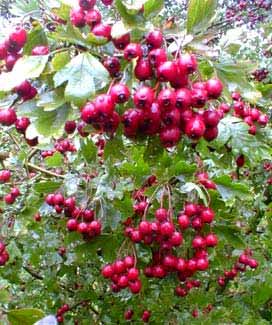 Despite the variety in growth habit, they're definitely all the same species. Such variety is common with hawthorns because they hybridize from mere proximity to other species, meaning a completely pure species plant with totally predictable habit cannot be expected. So partly from some of the specimens being trained & others left to their own devices, & partly because hawthorns can develop unpredictably, we are blessed with considerable variation in our five specimens, keeping any of them from seeming redundant.
Despite the variety in growth habit, they're definitely all the same species. Such variety is common with hawthorns because they hybridize from mere proximity to other species, meaning a completely pure species plant with totally predictable habit cannot be expected. So partly from some of the specimens being trained & others left to their own devices, & partly because hawthorns can develop unpredictably, we are blessed with considerable variation in our five specimens, keeping any of them from seeming redundant.I should add that except for the fountaining multi-stemmed specimen at the foot of the steps, which may or may not have been intentionally planted there (it seems perfectly positioned), the other four were definitely self-seeded & grow from odd locations no one would ever have intentionally chosen, such as right at the very edge of drop-offs where they root into stone retainer walls. The parent tree is a thirty-five or forty foot giant on the other side of the road, & a second giant is a half block away (shown below in autumn colors).
The whole neighborhood has been seeded from those two giants, thanks to birds scattering the fruit far & wide. Every homeowner has made their own decision whether to keep one, five, or none of the hawthorns that appear spontaneously in everyone's yards. I am constantly pulling up seedlings; we'd have dozens of hawthorns in no time if I left them.
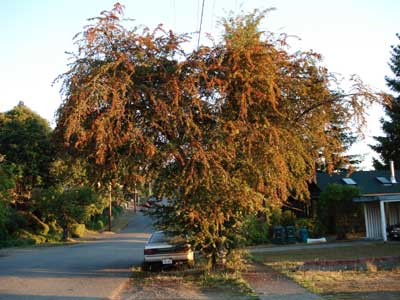 Many species of hawthorns were originally native of the Mediterranean regions & well into central Asia are, but are now naturalized throughout Europe & in North America, competing with our native species & blending with other species through incidental hybridization.
Many species of hawthorns were originally native of the Mediterranean regions & well into central Asia are, but are now naturalized throughout Europe & in North America, competing with our native species & blending with other species through incidental hybridization.The Hawthorn's negative traits is this invasive capacity which by now can never be reversed, & their bad habit of stabbing people.
It is otherwise perfect, with their positive traits legion: the stunning flowers, the handsome spring & summer fern-like foliage, the leaves' autumn yellows, large beautiful autumn berries that last through the winter, & the twisted glory of the berry-decorated limbs & rough bark after autumn leaf-fall.
The Russian Hawthorn in particular has a general hardiness in the face of winds & cold weather, so they can provide wind-breaks for more sensitive shrubs to the lee side, plus a root system that protects slopes.
They're extremely disease resistant, but we have had a problem with black aphids on one of the five hawthorns. That tree grows on a back corner utterly neglected, & has been several times harshly pruned on one side because it hangs over a neighbor's tomato garden & it seemed not unreasonable that he would request his garden's sunlight not be whittled away by that half-wild tree. It is the only stressed hawthorn of the five, so black aphids get on it most years.
In 2003 our region had its "once every fifteen years" tent-caterpillar population explosion, but happily the caterpillars were not interested in any of the beeches or the pin oak or the Mountain Ash nor the hornbeam nor any of the maples -- most of the trees never had even one caterpillar.
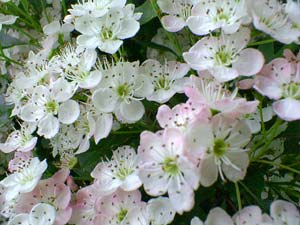 Neighbors had them by the ton & tent caterpillars were a major topic all that spring, but we had almost none. The caterpillars were moderately interested in our cherries, but we were able to snip off the tents before they were larger than a thumb; & our elderly chokecherry was assaulted by the caterpillars. which we treated organically with a bacillus.
Neighbors had them by the ton & tent caterpillars were a major topic all that spring, but we had almost none. The caterpillars were moderately interested in our cherries, but we were able to snip off the tents before they were larger than a thumb; & our elderly chokecherry was assaulted by the caterpillars. which we treated organically with a bacillus.Other than the chokecherry, the only other really annoying tent-caterpillar infestation we experienced was in the same hawthorn tree that annually attracts black aphids. Not surprisingly nearly all the tents were on the side that had been harshly pruned in the past, & it had to undergo another harsh pruning to bring down the tents. However, so hardy are hawthorns, even this one specimen, which has had its share of burdens, invariably looks nice the rest of the year, though I do sometimes think of chopping it down & planting something like a Western Cedar but not nearly so close to the property edge.
The May flowers on these tree & shrub hawthorns last three weeks, & give the trees their second most common name, May Trees. The flowers begin as small white balls & open into three-quarter-inch brilliant white blooms with little pink-tipped stamins that make it look like it has a circle of red dots within. These flowers are many & bright on all our specimens. The blooms in brightest sun are thickest, with many of the branches completely vanishing under white flowers. Their musky appleblossom scent only lasts about a week & is mainly detectiable late afternoon. Before days of artificial fragrances, hawthorn perfumes from Paris were highly regarded, & in Arabic erotic poetry it is said to be the scent of a woman's arousal.
The "haw" in Hawthorn is an old English word for hedgerow, so Hawthorn means "Thorny Hedge." After the English General Enclosures Act of 1845 hawthorns were planted in many places specifically to block peasant access to lands belonging to gentry or to the Crown. This considerably angered the populace that had traditionally regarded these as public lands for the common good & resented having thorny hedges put in the way of ancient paths.
The berry-like drupes are bitter when young, but in November or December after a few good hard frosts, they lose all bitterness, & are almost tasty enough to eat fresh from the tree, squeezing the pulp out of the tough skins. The pulp tastes like an old grainy apple. With the skins & seeds sieved, they make excellent jellies & sauces. They mix well with the rowanberries or with crabapples.
Spring buds provided one of the more unusual traditional uses as a tobacco substitute. The leaves, fruit, & flowers have been used in herbal medicines, believed by some to have a healing authority over the heart, improving blood flow, & retarding the aging process. It is not likely that its alleged curative powers exceed the placebo effect, but as a sacred tree, it was inevitably tried, & because the drupes are the color of blood, the magnificantly anti-scientific Doctrine of Signatures presumed hawberries were a remedy for conditions of the heart & blood.
Chinese herbal systems lit upon totally different assumptions about the value of hawthorn, or Shan Zha, as an aid for digestion. It is at least rich in Vitamin C & can be a beneficial food, but the tinctures, extracts, powders & pills popular among herbal hypochondriacs would have small if any effect on any actual illness.
Clinical trials to assess whether or not the folklore has any basis have thus far not been able to prove efficacy for hawthorn extracts or chemical components. It is not entirely out of the question that hawthorn has some blood-thinning chemical component that might after all be of some benifit to minor heart arrhythmias, though the evidence is too close to the placebo effect to say certainly. For people with more serious heart conditions, people who take hawthorn extracts for their condition are probabably interferring with the efficacy of prescription medications, & doing themselves some harm. Another claim from herb promoters is that it is of benifit to diabetes, but this has undergond doubleblind study, showing that there is no such benifit.
Herb-sucking nutcakes regularly risk the health of their children with crackpot fads. Hawthorn has been recommended, without basis in reality, for children with hyperactivity or inability to focus. An herbal product marketed as Calm Child Herbal Syrup consisted mostly of hawthorn & catnip. The hawthorn possibly damages the healing ability of scrapes & scratches by interferring with bloodclotting, while unproven for any health value whatsoever; & the catnip, though usually having no effect, can in some children cause drowsiness, which may be exactly what the annoyed parent is hoping for when drugging their kids, whether with ritelin, whiskey, or catnip. Parents who play Herbal Russian Roulette with their kids' health should be arrested & charged with child abuse & neglect.
One or another component of hawthorn might yet someday turn out to be useful for something, but what is certain is that the herb-pedlars' claims of definite values are so exaggerated as to constitute lies. For instance, hawthorn seeds do contain amygdalin (Laetril), as do the seeds of all rose-family plants. This component has long been the focus of a shockingly paranoid alternate-medicine fad that assumes all trained physicians in North America are part of a sinister conspiracy which delights in watching their sickest patients drop dead, & the only exceptions on the planet are a few Latin American quacks selling Laetrile injections to cancer patients.
The photos on this page were snapped during May flowering, except the fruit portrait snapped in late October. For pictures of other of the five hawthorns in our yards, & to find out about some of the rich folklore of sacred hawthorns, jump to the article Myths & Legends of the Hawthorn Tree. See also the subsidiary pages showing Autumn Hawberries, & of Winter Hawberries.